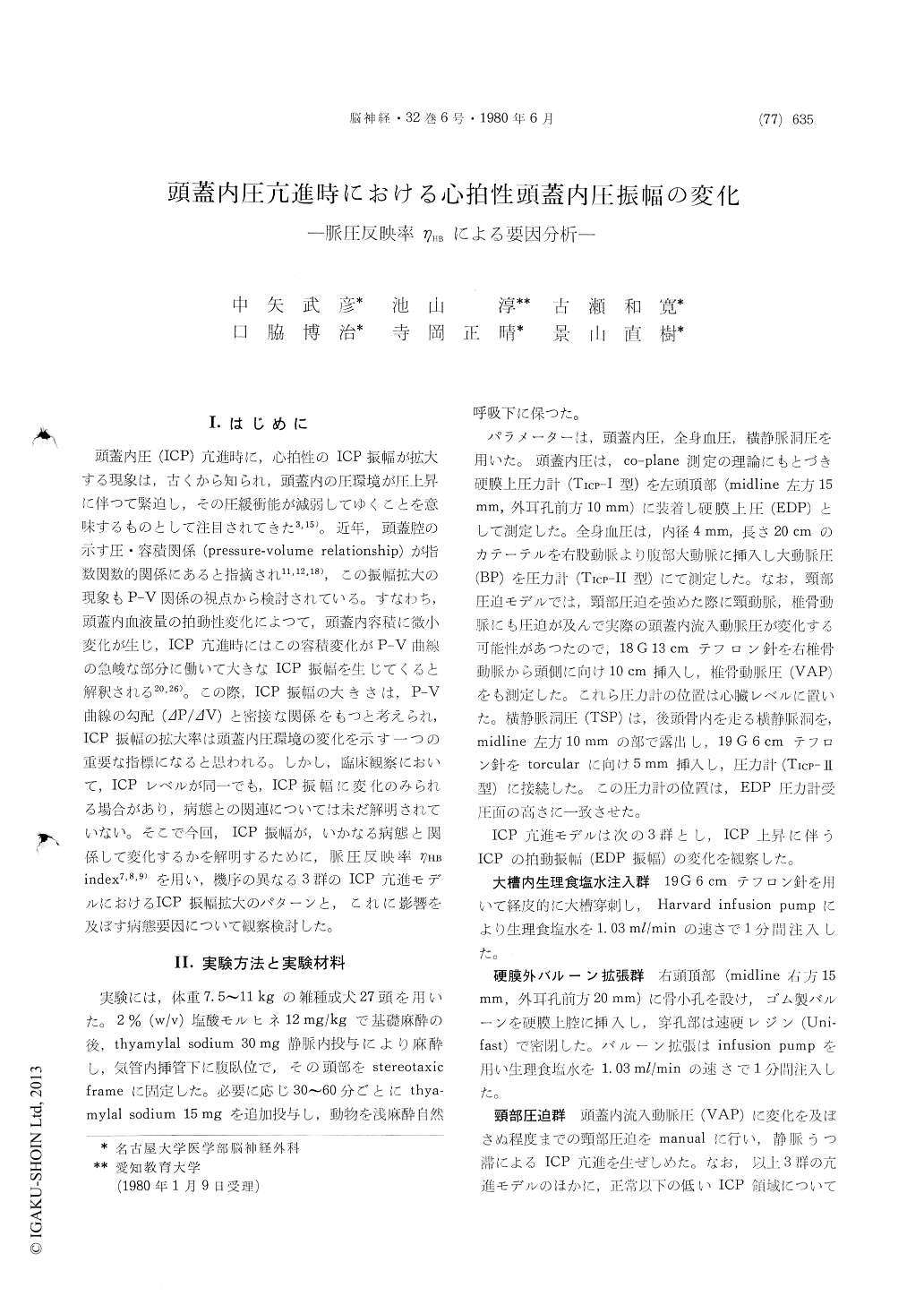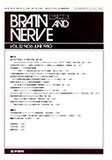Japanese
English
- 有料閲覧
- Abstract 文献概要
- 1ページ目 Look Inside
I.はじめに
頭蓋内圧(ICP)亢進時に,心拍性のICP振幅が拡大する現象は,古くから知られ,頭蓋内の圧環境が圧上界に伴つて緊迫し,その圧緩衝能が減弱してゆくことを意味するものとして注目されてきた3,15)。近年,頭蓋腔の示す圧・容積関係(pressure-volume relationship)が指数関数的関係にあると指摘され11,12,18),この振幅拡大の現象もP-V関係の視点から検討されている。すなわち,頭蓋内血液量の拍動性変化によつて,頭蓋内容積に微小変化が生じ,ICP亢進時にはこの容積変化がP-V 曲線の急峻な部分に働いて大きなICP振幅を生じてくると解釈される20,25)。この際,ICP振幅の大きさは,P-V曲線の勾配(ΔP/ΔV)と密接な関係をもつと考えられ,ICP振幅の拡大率は頭蓋内圧環境の変化を示す一つの垂要な指標になると思われる。しかし,臨床観察において,ICPレベルが同一でも,ICP振幅に変化のみられる場合があり,病態との関連については未だ解明されていない。そこで今回,ICP振幅が,いかなる病態と関係して変化するかを解明するために,脈圧反映率ηHBindex7,8,9)を用い,機序の異なる3群のICP亢進モデルにおけるICP振幅拡大のパターンと,これに影響を及ぼす病態要因について観察検討した。
It is documented that intracranial hypertension accompanies increase in pulse amplitude (PA) of ICP. From the concept of pressure-volume relation-ship, PA of ICP is closely related to the slope of P-V curve in the intracranial cavity. Mathemati-cally, if a P-V curve were exponential, the PA-mean ICP curve would be a straight line. In neurological practice, the slope of the line is foundto show considerable differences in terms of the intracranial pathology. This experimental study is intended to clarify factors behind increase in PA from the concept of driving pressure.
Experiments were carried out on 27 mongrel dogs. Epidural pressure (EDP), systemic blood pressure (BP) from the abdominal aorta, and trans-verse sinus pressure (TSP) were recorded in 3 groups of animal models, namely, supratentrial epidural balloon inflation (1.03 ml/min.), cisternal saline injection (1.03 ml/min.), and neck compression maneuvers. Degree of PA increase was calculated by the following ηHB index,
ηHB=PA of EDP/PA of BP×100(%)
and the correlation between, πHB and ICP was observed.
A marked linear correlation between raised ICP and ηHB was observed in both cisterna magna injection and balloon inflation. In general, the increase in HB with balloon inflation was slightly larger than with cisterna magna injection. No significant TSP changes were observed during these experimental procedures. Neck compression induced a prompt rise in TSP as in EDP. The increase in ηHB and PA of ICP, however, was significantly smaller than with the other two models. Usually, the ηHB increase had a close correlation with the ICP-TSP difference. When the difference was small, ηHB exhibited little increase in spite of high ICP. Moreover, ηHB and PA were also affected by the pulse rate. Bradycardia induced high ηHB.
These findings show that ICP-BP dependence increases more or less in terms of ICP. Transfer of pressure from the arterial system to CSF may be influenced by vasomotor tone, CSF circulation, and venous drainage from cranial cavity. It was suggested that the difficulty of venous drainage from the cranial cavity to the extracranial system played an important role in PA increase in ICP. Heart rate also affected PA increase.

Copyright © 1980, Igaku-Shoin Ltd. All rights reserved.


